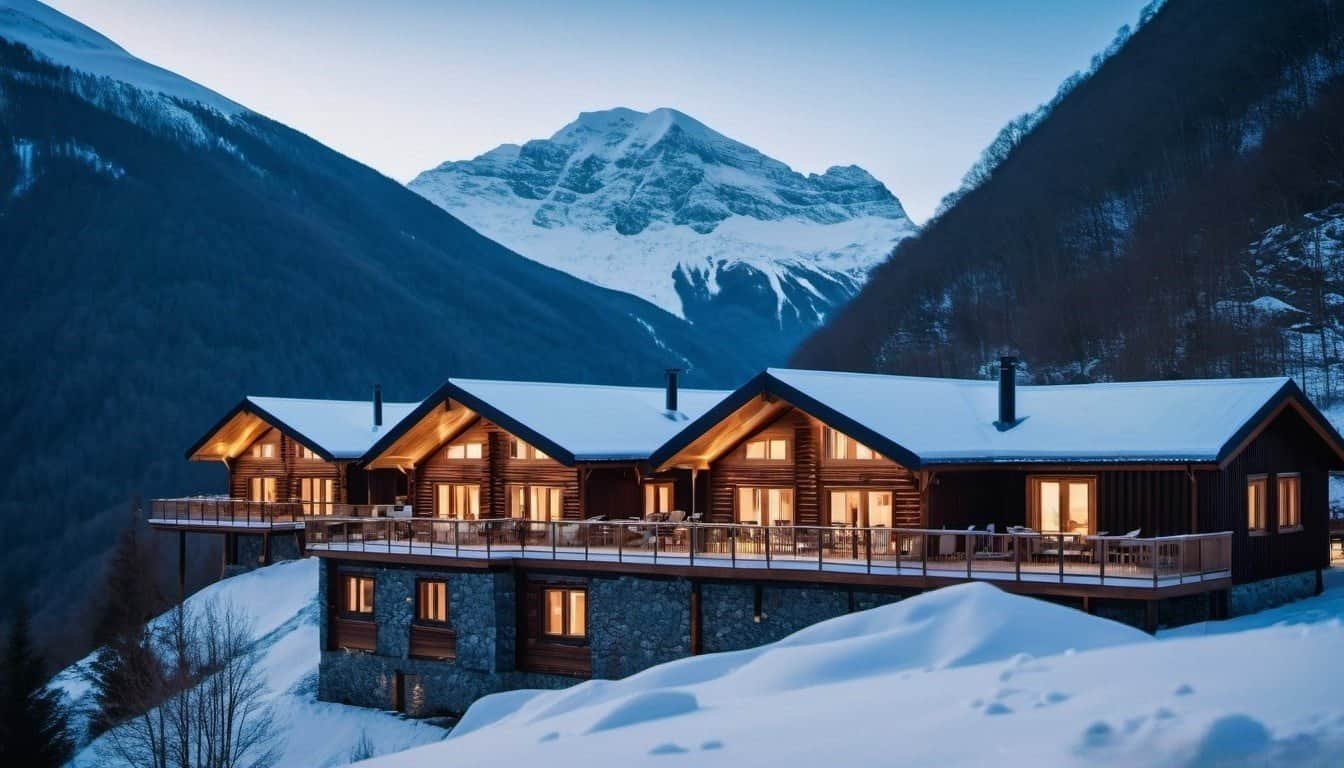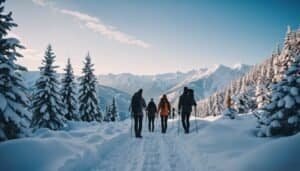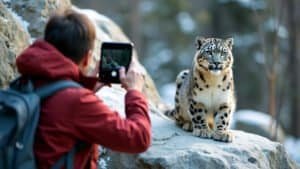Introduction
The increasing popularity of snow leopard habitats as tourist destinations poses both opportunities and challenges. While tourism can raise awareness and generate funds for conservation, it also threatens these fragile ecosystems if not managed properly
This article will explore the main threats posed by tourism, the benefits of eco-tourism, and essential guidelines for responsible travel in snow leopard regions. We will also examine how local communities can play a vital role in conservation efforts and discuss sustainable infrastructure development. By understanding and implementing these strategies, we can ensure that tourism helps rather than harms snow leopard habitats
Main Threats To Snow Leopard Habitats From Tourism
Tourism in snow leopard habitats presents unique challenges that can severely impact these elusive and endangered animals
While the economic benefits of tourism are undeniable, the increased human presence in these remote regions can lead to significant disturbances in the natural behavior and habitats of snow leopards. Understanding the specific threats posed by tourism is crucial to implementing effective management strategies that protect these big cats while still allowing for sustainable tourism
Tourist Activities And Habitat Disturbance
One of the most significant threats to snow leopard habitats from tourism is the disturbance caused by tourist activities. As visitors trek through the mountainous regions where snow leopards reside, they can unintentionally disrupt the animals’ natural behavior
Snow leopards are notoriously elusive and avoid human interaction whenever possible. Increased human presence can lead to changes in the snow leopards’ movement patterns, hunting behaviors, and even their reproductive success
Moreover, the noise and activity from tourists can drive prey species like ibex and blue sheep away from their usual habitats, forcing snow leopards to expend more energy in search of food. This disruption can lead to reduced hunting success and increased energy expenditure, which is particularly concerning in the harsh conditions of high-altitude environments
Impact Of Infrastructure Development
The construction of tourism infrastructure, such as roads, hotels, and observation points, is another major threat to snow leopard habitats. Infrastructure development often involves the clearing of land, which can lead to habitat fragmentation
Fragmented habitats can isolate snow leopard populations, limiting their ability to find mates and reducing genetic diversity. Additionally, the construction process itself can disturb the landscape, leading to soil erosion, landslides, and the destruction of vegetation that snow leopards and their prey rely on
The development of roads and trails in these mountainous regions can also lead to increased human access to previously remote areas, further encroaching on snow leopard territory. This not only disrupts their natural behaviors but also increases the risk of human-wildlife conflicts, such as livestock depredation by snow leopards, which can result in retaliatory killings by local communities
Waste Management Challenges
Poor waste management practices in tourist areas can have severe ecological impacts on snow leopard habitats
Litter and improperly disposed waste can attract scavengers like crows and foxes, which compete with snow leopards for food. These scavengers can also spread diseases to wildlife, further threatening the health of snow leopard populations
Furthermore, the accumulation of waste in high-altitude areas, where decomposition occurs slowly, can pollute water sources and degrade the environment. The presence of non-biodegradable waste, such as plastic, in these pristine environments can have long-lasting effects on both wildlife and the broader ecosystem
To mitigate these threats, it is essential to implement strict waste management protocols in snow leopard habitats
This includes educating tourists on responsible waste disposal, providing adequate waste collection facilities, and ensuring that all waste is removed from the area and disposed of properly. By addressing waste management challenges, we can help preserve the delicate balance of these ecosystems and protect the snow leopards that inhabit them
Benefits Of Eco-Tourism In Snow Leopard Conservation
While tourism can pose significant risks to snow leopard habitats, eco-tourism offers a sustainable alternative that not only minimizes environmental impact but also contributes positively to conservation efforts
By focusing on responsible and environmentally conscious travel, eco-tourism can play a pivotal role in protecting snow leopards and their habitats, while also providing economic benefits to local communities
Promoting Sustainable Tourism Practices
Eco-tourism is centered on minimizing the negative impact of tourism on the environment and wildlife
This includes limiting the number of visitors to sensitive snow leopard habitats, encouraging low-impact activities such as guided wildlife viewing and nature photography, and promoting the use of eco-friendly accommodations. By adhering to these practices, eco-tourism reduces habitat disturbance, ensuring that snow leopards can continue their natural behaviors with minimal human interference
Sustainable tourism practices also involve educating tourists about the importance of conservation. Eco-tourism operators often provide information on the threats facing snow leopards and the steps being taken to protect them, fostering a deeper appreciation and understanding among visitors
This awareness can lead to increased support for conservation initiatives, both financially and through advocacy
Economic Incentives For Local Communities
Eco-tourism can provide significant economic benefits to local communities living in snow leopard habitats
By offering employment opportunities in tourism-related activities, such as guiding, hospitality, and wildlife monitoring, eco-tourism creates a financial incentive for communities to protect their natural resources and wildlife. This economic reliance on a healthy ecosystem encourages local people to participate in conservation efforts and adopt practices that reduce human-wildlife conflict
For example, in regions where eco-tourism is well-established, communities are less likely to engage in activities that harm snow leopards, such as poaching or retaliatory killings due to livestock predation. Instead, they are more inclined to adopt livestock management practices that reduce the risk of depredation, supported by the income generated from eco-tourism
In some areas, eco-tourism has also led to the establishment of community-managed conservation areas, where local residents take an active role in monitoring and protecting wildlife. These community-led initiatives often result in more effective conservation outcomes, as they are based on a deep understanding of the local environment and a vested interest in its preservation
Educating Tourists On Wildlife Conservation
One of the key benefits of eco-tourism is its ability to educate tourists about the importance of conserving snow leopards and their habitats
Eco-tourism operators often incorporate educational components into their tours, providing visitors with insights into the challenges facing snow leopards, such as habitat loss, climate change, and human-wildlife conflict
These educational experiences can be transformative for tourists, fostering a sense of responsibility and a commitment to conservation. Visitors who learn about the plight of snow leopards are more likely to support conservation efforts through donations, advocacy, or by adopting sustainable travel practices in the future
Moreover, by raising awareness among tourists, eco-tourism helps to build a global network of conservation advocates who can contribute to the protection of snow leopards beyond their visit. This broader support is essential for securing the long-term survival of snow leopards, as it helps to generate the resources and political will needed to implement effective conservation measures
Guidelines For Responsible Tourism In Snow Leopard Areas
Responsible tourism is crucial for protecting snow leopard habitats while allowing people to experience the beauty of these remote regions. By following specific guidelines, tourists and tour operators can minimize their impact on the environment and contribute positively to conservation efforts
These guidelines emphasize the importance of reducing human interference, supporting local conservation initiatives, and ensuring that tourism activities are conducted in an ethical and sustainable manner
Limiting Visitor Numbers And Footprint
One of the most effective ways to manage tourism in snow leopard habitats is by limiting the number of visitors
Overcrowding can lead to significant habitat disturbance, increased waste, and greater pressure on local resources. To address this, it is essential to establish visitor quotas for particularly sensitive areas, ensuring that the number of tourists does not exceed the carrying capacity of the environment
Tour operators and conservation organizations can collaborate to create controlled access points and designated trails that minimize the impact on snow leopard habitats. By restricting human activity to certain areas, the majority of the habitat remains undisturbed, allowing snow leopards and other wildlife to thrive with minimal human interference
Additionally, tourists should be encouraged to travel in small groups, reducing their collective footprint and making it easier to manage their impact on the environment. Tourists can also be guided on how to minimize their personal footprint by using eco-friendly products, staying on marked paths, and avoiding activities that could disturb wildlife
Ethical Wildlife Viewing Practices
Ethical wildlife viewing is a cornerstone of responsible tourism, particularly in snow leopard habitats
Tourists must be educated on the importance of observing wildlife from a distance, using binoculars or telephoto lenses rather than approaching animals too closely. This practice helps to prevent stress and disturbance to the snow leopards, which are notoriously shy and elusive
Tour operators should also enforce strict guidelines that prohibit baiting or otherwise manipulating snow leopards or their prey for the sake of better photo opportunities. Such practices not only disrupt the natural behavior of wildlife but can also lead to long-term negative consequences, such as habituating animals to human presence or altering their hunting patterns
Moreover, tourists should be made aware of the importance of silence and patience when viewing wildlife
The less intrusive their presence, the more likely they are to witness the natural behaviors of snow leopards without causing harm. Tour guides can play a key role in educating visitors about these principles and ensuring that all participants adhere to them
Support For Conservation Projects
Responsible tourism in snow leopard areas goes beyond minimizing harm; it also involves actively supporting conservation efforts. Tourists can contribute to snow leopard conservation by participating in tours or activities that directly fund or assist local conservation projects
For example, some eco-tourism operators donate a portion of their profits to snow leopard conservation initiatives or involve tourists in citizen science projects, such as tracking snow leopard movements or monitoring prey species
Tourists can also support conservation efforts by choosing accommodations and tour operators that adhere to sustainable practices and have a proven commitment to protecting the environment
This might include staying in eco-lodges that use renewable energy, employ local people, and minimize waste, or selecting tour companies that partner with conservation organizations and follow strict environmental guidelines
By making informed choices and prioritizing ethical and sustainable options, tourists can ensure that their visit contributes to the long-term survival of snow leopards and the preservation of their habitats
Community Involvement In Managing Tourism Impacts
Engaging local communities in the management of tourism is essential for the long-term conservation of snow leopard habitats. Communities that live in close proximity to these habitats have a deep understanding of the environment and a vested interest in its preservation
By involving them in tourism management, conservation efforts become more effective and sustainable. This section explores how empowering local communities, supporting community-led conservation initiatives, and fostering collaborations between NGOs and local groups can help mitigate the impact of tourism on snow leopard habitats
Empowering Local Communities
Empowering local communities to take an active role in tourism management is crucial for the success of conservation efforts
When local people are given the tools, resources, and authority to manage tourism in their regions, they are more likely to develop practices that are both culturally appropriate and environmentally sustainable
This empowerment often includes training in eco-tourism, wildlife monitoring, and sustainable resource management, enabling community members to benefit from tourism while protecting their natural heritage
For instance, community-based tourism models allow local residents to directly manage tourist activities, ensuring that they are conducted in a manner that minimizes environmental impact
These models also provide local people with the opportunity to share their knowledge and culture with visitors, fostering a deeper connection between tourists and the environment. By empowering communities, tourism becomes a source of pride and a means to preserve their cultural and natural resources
Community-Led Conservation Initiatives
Community-led conservation initiatives are vital for the protection of snow leopard habitats. These initiatives often involve local residents in monitoring wildlife, protecting critical habitats, and implementing measures to reduce human-wildlife conflict
By involving the community in these efforts, conservation becomes more effective, as local people have a detailed understanding of the landscape, wildlife behavior, and potential threats
One successful example of community-led conservation is the Snow Leopard Enterprises program, which operates in several snow leopard range countries. This program provides training and resources for local women to produce and sell handicrafts, with a portion of the profits going towards snow leopard conservation
In return, the participating communities agree to protect snow leopards and their prey, creating a mutually beneficial relationship between conservation and economic development
Another example is the formation of local conservation committees, which work in partnership with NGOs to monitor snow leopard populations and protect key habitats. These committees often include members from various sectors of the community, such as herders, farmers, and local leaders, ensuring that a wide range of perspectives are considered in conservation planning
Collaborations Between NGOs And Local Groups
Collaborations between non-governmental organizations (NGOs) and local groups are essential for addressing the complex challenges of managing tourism in snow leopard habitats
NGOs can provide the technical expertise, funding, and global networks needed to support local conservation efforts, while local groups bring invaluable knowledge of the landscape, culture, and community dynamics
These collaborations can take many forms, from joint conservation projects to training programs that build local capacity in wildlife management and eco-tourism
For example, the Snow Leopard Trust has partnered with local communities in Mongolia, India, and other snow leopard range countries to implement conservation programs that involve local people in monitoring snow leopard populations, protecting prey species, and reducing human-wildlife conflict
Such collaborations also play a crucial role in developing and enforcing guidelines for responsible tourism. By working together, NGOs and local groups can ensure that tourism is managed in a way that benefits both the environment and the community
This might involve creating community-managed conservation areas, developing eco-tourism guidelines, or establishing monitoring systems to track the impact of tourism on snow leopard habitats
Developing Sustainable Tourism Infrastructure
Sustainable tourism infrastructure is crucial for minimizing the impact of tourism on snow leopard habitats. The design, construction, and operation of tourism facilities must prioritize environmental sustainability to protect these fragile ecosystems
This section explores how eco-friendly lodging, minimizing the environmental footprint, and the use of renewable energy sources can contribute to sustainable tourism in snow leopard regions
Eco-Friendly Lodging And Facilities
The development of eco-friendly lodging is essential for reducing the environmental impact of tourism in snow leopard habitats. Eco-lodges, often built using sustainable materials and designed to blend seamlessly with the natural landscape, provide a model for how tourism can coexist with conservation. These lodges typically use locally sourced materials, such as stone or wood, which not only reduce the carbon footprint associated with transportation but also support local economies.
In addition to sustainable construction practices, eco-lodges often incorporate energy-efficient systems, water conservation measures, and waste reduction strategies
For example, some lodges use composting toilets, solar water heaters, and rainwater harvesting systems to minimize their environmental impact. These practices help to preserve the pristine nature of snow leopard habitats, ensuring that tourism does not degrade the very environments that visitors come to experience
Tourists who choose to stay in eco-friendly accommodations also contribute directly to conservation efforts, as many eco-lodges reinvest a portion of their profits into local conservation projects. By supporting these lodges, visitors can enjoy a more sustainable travel experience while helping to protect snow leopard habitats
Minimizing Environmental Footprint
Minimizing the environmental footprint of tourism infrastructure involves careful planning and design to reduce the impact on snow leopard habitats
This includes selecting locations for tourism facilities that avoid critical habitats and migration corridors, as well as using construction methods that minimize land disturbance. For instance, building on stilts or using modular designs can reduce the amount of land that needs to be cleared, preserving more of the natural environment
In addition to thoughtful site selection, tourism infrastructure should be designed to operate with minimal resource consumption
This can be achieved through energy-efficient buildings, low-water-use landscaping, and the integration of sustainable transportation options, such as electric vehicles or bicycles, for guests. By reducing the consumption of natural resources, tourism operations can lessen their overall impact on the environment
Furthermore, the management of waste and wastewater is a critical component of minimizing the environmental footprint. Effective waste management practices, such as recycling programs, composting, and the use of biodegradable products, can help to prevent pollution in snow leopard habitats
Similarly, treating and reusing wastewater for irrigation or other purposes reduces the strain on local water resources and prevents contamination of natural water bodies
Use Of Renewable Energy Sources
The use of renewable energy sources in tourism infrastructure is another key element of sustainable development. Renewable energy, such as solar, wind, or hydropower, provides a clean and reliable source of power that reduces the reliance on fossil fuels and lowers greenhouse gas emissions
In snow leopard habitats, where the environment is particularly sensitive to climate change, the adoption of renewable energy is crucial for reducing the carbon footprint of tourism activities
Solar power is especially well-suited for remote, high-altitude regions where snow leopards are found, as these areas often receive abundant sunlight
Solar panels can be used to power lodges, heat water, and charge electric vehicles, providing a sustainable energy solution that has minimal impact on the environment. Wind power, although less common, can also be harnessed in certain areas to generate electricity for tourism facilities
In addition to reducing emissions, the use of renewable energy can also serve as a model for sustainable development in local communities. By demonstrating the viability of renewable energy, tourism operations can inspire local residents to adopt similar practices, further contributing to the preservation of snow leopard habitats
Conclusion
Effective management of tourism in snow leopard habitats is essential for the conservation of these elusive and endangered animals. By understanding and addressing the main threats posed by tourism—such as habitat disturbance, infrastructure development, and waste management—conservationists can mitigate the negative impacts on snow leopards and their environment
Eco-tourism offers a promising solution, promoting sustainable practices that benefit both wildlife and local communities. Additionally, responsible tourism guidelines help ensure that visitors contribute to conservation efforts rather than harm them
Community involvement is a key factor in managing tourism sustainably. By empowering local residents and supporting community-led conservation initiatives, the impact of tourism can be managed more effectively. Collaborations between NGOs and local groups further strengthen these efforts, ensuring that tourism supports rather than undermines conservation goals
Finally, developing sustainable tourism infrastructure—through eco-friendly lodging, minimizing environmental footprints, and using renewable energy—ensures that tourism in snow leopard regions is both environmentally and economically sustainable. Through these combined efforts, tourism can become a powerful tool for snow leopard conservation, preserving these majestic animals and their habitats for generations to come










